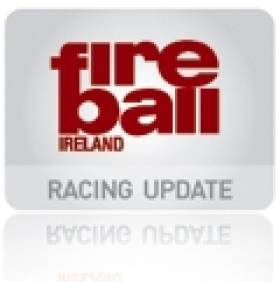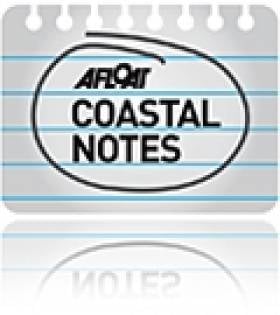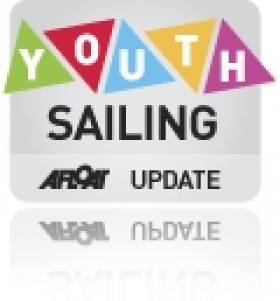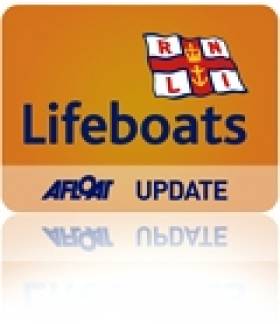Displaying items by tag: Ballyholme
McGrotty and Grimes Win Fireball Ulster Title
Representatives from Skerries (2), Clontarf (1), Howth (2), East Down Yacht Club (1), Sligo Yacht Club (1) were joined a composite crew from Cushendal Sailing and Boating Club/Royal St. George Yacht Club and eleven boats from Dun Laoghaire.
In times past the Fireball Class were regular visitors to Ballyholme, particularly when they hosted a week-long dinghy regatta, but in the time of this scribe’s association with the Irish Fireball Class this has been our first visit. Ballyholme has had a solitary Fireballer in recent times, but unfortunately Denis Findlay lost his struggle with cancer and so he was unable to enjoy the return of the class to this venue on Belfast Lough.
Race Officer Robin Gray, RYA N. Ireland’s Race Officer Co-ordinator did the honours over the weekend and enhanced his reputation as an excellent RO with three superb races on Saturday when we enjoyed a sea breeze of 15/16 knots. In addition to good courses we enjoyed sea conditions that gave us excellent surfing conditions and saw a few stories of rogue breaking waves in Saturday’s post-mortems. Turnaround times for races were good to the extent that after a solitary black flag start in Race 1, after a General Recall, three hour long races were sailed in beautifully sunny conditions that saw the fleet ashore and showered by 16:30.
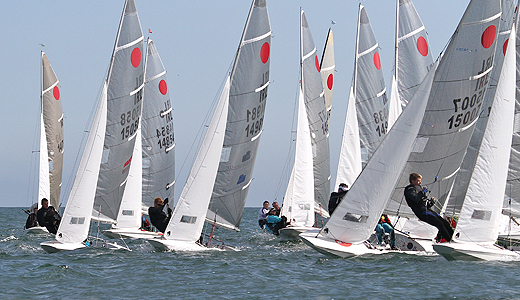
I gather that Sunday was not quite as co-operative from a wind perspective as the wind started light and moved around much more. Due to a family bereavement, I missed the day’s proceedings but was updated on how the day panned out.
Day 1 was claimed by Simon McGrotty & Ruari Grimes who won races 1 and 3 with good upwind speed on the beat and excellent boat handling off wind, particularly in the tight first reaches of the triangles. The blot on their day 1 record was a fourth place which may have been influenced by a wandering gybe mark which had to be substituted by a rib flying an X Flag. There certainly was the unusual sight of Fireballs beating and tacking towards the gybe mark and McGrotty/Grimes may have lost places here. Kenny Rumball & Seamus Moore, Barry McCartin & Conor Kinsella and Damien Bracken & Brian O’Hara were able to take advantage by filling the first three places before McGrotty/Grimes finished in fourth.
After three excellent races, the standings were as follows;
1. Simon McGrotty & Ruari Grimes 6pts (1,4,1)
2. Kenny Rumball & Seamus Moore 8pts (4,1,3)
3. Barry McCartin & Conor Kinsella 10pts (6,2,2)
4. Noel Butler & Stephen Oram 13pts (2,7,4)
5. Louis Smyth & Cormac Bradley 16pts (3,8,5)
The silver fleet was 5-strong for this regatta and included a visitor from the UK. Hannah Showell teamed up with Margaret Casey to provide the third all-female crew of the event and together with Cariosa Power & Marie Barry, Mary Chambers & Brenda McGuire, they contested the regatta with Kate Grimes (helm), Martina Michels (crew) and Karen Caughey (crew), the latter three being joined by Nick Malone, Cearbhall Daly and John Orr respectively. Diane Kissane was the sole female outside the Silver fleet, sailing 14939.
What is encouraging for the Irish fleet at this point in time is the influx of young talented sailors into the class. Yes, it may be coincidental with the hosting of the Worlds, but it seems that they are enjoying themselves and there is a camaraderie that is developing among them and with the more “established” members of the fleet. This weekend we were joined by Luke Malcolm & Shane Diviney who bought a Fireball on the back of the Leinsters sailed in their home club of Howth last year. Howth is also scheduled to host the 2012 Nationals and we hope to have fledgling fleet there by the time we visit next summer.
Barry McCartin has joined the fleet from the Topper Class where he has enjoyed significant success. Diane Kissane has proven her pedigree in Optimists and has been showed a great turn of speed and ability to handle the Fireball in a very short time. There are other young recruits to the class who contested the Worlds in Ben Malone and Ben Scallan and the hope must be that we can continue to attract this age of competitor to ensure that we remain at the forefront of domestic sailing in Ireland and beyond.
My detail on Sunday’s proceedings is based on word of mouth reports from my helm, but I gather that the day’s wind wasn’t quite as steady as Saturday’s. It doesn’t seem to have upset the McGrotty/Grimes charge to the title as they bagged another two firsts to give themselves two-thirds of the regatta’s race wins. The one that “got away” on Sunday went to Frank Miller and Grattan Donnelly.
Counting all races, for the sake of analysis, Conor Clancy & Francis Rowan won by a healthy margin, counting a 2,2,4 for the day. On Saturday they had a complicated capsize in race 1 and retired from Races 2 & 3 due to a broken spreader. Thus while they didn’t feature overall on Saturday evening their success on Sunday saw them finish 7th overall.
McGrotty/Grimes had the next best daily score of 12 points (1,10,1), the 10th becoming their discard, with Rumball/Moore next best with 5,6,2. Butler/Oram’s travails continued with a 4,5,5, for the day which is completely inconsistent with their recent form. Damien Bracken and Brian O’Hara also had a better day with a 8,4,3.
In the Silver Fleet Hannah & Margaret had a three point lead over Cearbhall & Martina at the close of racing on the Saturday evening, with Cariosa & Marie in third place a further three points adrift. Cariosa & Marie won the second day with two finishes just outside the top ten and an 18th to Hannah/Margaret’s 11,12,DNF to leapfrog Cearbhall/Martina into 2nd place in the Silver fleet.
As ever with our northern visits, the hospitality of Ballyholme Yacht Club was excellent with a dinner arranged for the Saturday night at which some unfinished business (a prize-giving) from the Open Championships was concluded. The atmosphere in the Club was welcoming and in particular their provision of race results on both Saturday evening and Sunday afternoon was very fast with multiple score sheets being made available.
Robin Gray will definitely be on our wish list for future events, particularly as he ran the regatta exactly as we asked him to. Our thanks also go to Mark Markey, Rear Commodore Sailing who coordinated our visit from a BYC perspective.
The Class now enjoys a month’s break until the Nationals which are being hosted by Dun Laoghaire Motor Yacht Club on Dublin Bay over the last Friday/Saturday/Sunday of August, 26 – 28th. Class coordinator for this event, Neil Colin, has secured sponsorship from Pinnell & Bax and the regatta documentation can be found on both the Irish Fireball website and the club website.
The decision to go with a Dublin venue was taken in view of the two-week Worlds regatta in Sligo so that we didn’t have to embrace another distance regatta for the Nationals. Additionally, in recent years the Nationals have been hosted outside the capital (Baltimore, Westport (x2), Cork, Fenit, Wicklow) and the feeling was that it was time for them to return.
|
Pos |
Sail No |
Crew |
R1 |
R2 |
R3 |
R4 |
R5 |
R6 |
Nett |
|
1 |
14981 |
Simon McGrotty & Ruari Grimes |
1 |
4 |
1 |
1 |
10 |
1 |
8 |
|
2 |
15058 |
Kenneth Rumball & Seamus Moore |
4 |
1 |
3 |
5 |
6 |
2 |
15 |
|
3 |
14820 |
Barry McCartin & Conor Kinsella |
6 |
2 |
2 |
6 |
3 |
7 |
19 |
|
4 |
15061 |
Noel Butler & Stephen Oram |
2 |
7 |
4 |
4 |
5 |
5 |
20 |
|
5 |
14904 |
Damien Bracken & Brian O’Hara |
20 |
3 |
6 |
8 |
4 |
3 |
24 |
|
|
|
|
|
|
|
|
|
|
|
|
14 |
14775 |
Hannah Showell & Margaret Casey |
12 |
13 |
13 |
11 |
12 |
20 |
61 |
|
15 |
14854 |
Cariosa Power & Marie Barry |
15 |
14 |
15 |
18 |
11 |
11 |
66 |
|
16 |
14877 |
Cearbhall Daly & Martina Michels |
14 |
15 |
12 |
14 |
18 |
13 |
68 |
Ireland's Bathing Spots Among Cleanest in Europe
Ireland has ranked fifth in a new Europe-wide report on bathing water quality - but some beaches in Northern Ireland are falling short of strict EU standards.
MEP Jim Higgins welcomed the results of the annual Bathing Water Report for 2010, saying: "Ireland's scenic attributes are a primary reason for attracting tourists and it is essential that our coastal and inland bathing sites are also enticing."
Ireland has moved up five places from its overall rank of 10th in 2009, with 90.1% of all bathing water sites meeting the EU's Blue Flag guidelines for water quality at beaches and swimming spots.
However, the Daily Telegraph reports that a number of beaches in Northern Ireland and other parts of the UK were judged to be 'poor'.
Beaches at Newcastle and Ballyholme in the North are among 16 across the UK that did not pass the EU's strict checks for Blue Flags.
The 2010 report ranks Cyprus as the cleanest bathing spot in Europe, with 100% of sites passing EU insspection. It was closely followed by Croatia with 97.3%, Malta at 95.4% and Greece at 94.2%.
Royal Cork Yacht Club sailors have lifted two national titles at the 2011 Mitsubishi National Youth Sailing Championships this afternoon in a series cut short today by gale force winds on Dublin Bay. SCROLL DOWN FOR THIS AFTERNOON'S PRIZEGIVING PHOTOS.
Local knowledge offered no advantage as Dun Laoghaire co-hosts the Royal St. George YC, the National Yacht Club and the Royal Irish YC won none of the five national titles inspite of strong turnouts fielded by each of the waterfront clubs.
With winds gusting up to 25-30 knots and easterly winds causing a big swell, sailing for the final day of the ISA Mitsubishi National Championships was cancelled leaving the 300 sailors ashore. However all classes had completed sufficient races to complete the series.
The event was an important test event for Dun Laoghaire organisers of the Youth Worlds which will be held in the same venue from 12 -21 July 2012.
In a show of strength from the regions the three other titles went to other east coast clubs at Howth, Ballyholme and Courtown.
Immediately after the prizegiving, (photos below) Olympic Team Manager James O'Callaghan named the Irish team for the 2011 ISAF Youth World Championships in Croatia in July based on the weekend results. Listen to the podcast with the team manager, talking about the stand out performances of the weekend, the current strength of youth sailing in Ireland and the prospect of a top finish in Croatia.
Royal Cork YC achieved two national titles with Laser 4.7 event favourite Seafra Guilfoyle winning the title having previously dominated the Optimist fleet in previous years.
Brother and sister team Patrick & Chloe Crosbie also from Royal Cork won the 420 National title and Patrick was awarded the Training Grant for the most promising sailor at the event.
This event was the national trials for the Optimist class which was won by Tralee Bay sailor Sophie Browne who will travel to New Zealand in December to compete in the Optimist World Championships.
Irish optimist sailors are performing well internationally at the moment finishing fourth and fifth at the Braassemermeer Easter regatta. Other events during 2011 where there will be Irish representation include the European Championships in Portugal and the National Championships in Germany and the UK.
Top three results below. Click the links for full results class by class.
Laser Radial - full results here
National Champion: Philip Doran (Courtown Sailing Club)
2nd Robbie Gilmore (Strangford Lough YC)
3rd Eoin Keller (Lough Derg YC)
1st Girl Sophie Murphy Quoile Yacht Club
Laser 4.7 - full results here
National Champion: Seafra Guilfoyle (Royal Cork YC)
2nd Darragh O'Sullivan (Kinsale YC)
3rd Finn Lynch (NYC/Blessington SC)
1st Girl: Sian Kneafsey (National YC)
420 - full results here
National Champions: Patrick Crosbie & Chloe Crosbie (Royal Cork YC)
2nd Aodh Kennedy & Daniel Browne (Kinsale YC & Tralee Bay SC)
3rd Emma Geary & Niamh Connolly (Royal Cork YC & Baltimore SC)
Feva - full results here
National Champions: D Johnston & L Flynn Byrne (Howth YC)
2nd C Totterdell & S Craig (National YC/Royal St. George YC)
3rd C Mollard & J Harris (Howth YC)
Topper - full results here
National Champion: T Brow (Ballyholme YC)
2nd Laura Gilmore (Strangford Lough YC)
3rd Andrew Penney (East Antrim BC)
Optimist (Championship fleet)
1st Ben Walsh (Skerries SC)
2nd Ross Quirke (National YC)
3rd Colin O'Sullivan (Malahide YC)
Optimist National Trials
Sophie Browne (Tralee Bay SC) won the trials and took the option of travelling to New Zealand in December 2011 to represent Ireland at the Optimist World Championships.
The following sailors were selected by the trial process to represent Ireland at the European Championship which will be held in Portugal in July 2011: Sean Donnelly, HYC, Peter McCann RCYC, Harry Whitaker RCYC, Eoin Lyden RCYC, Jil McGinley RCYC Cliodhna Ni Shuilleabhain KYC and Megan Parker SSC
The team selected to travel to the German National Championships include Robert Dickson HYC , Daire Cournane KYC, Sean Waddilove Skerries SC, Richard Hogan HYC, Adam Hyland RSGYC, Ronan Cournane KYC, Sean Gambier Ross KYC and Fergus Flood HYC, Aoife Hopkins and Alacoque Daly Tralee Bay SC.
In addition 10 sailors were chosen for the Irish under 12 squad who will compete in the Optimist UK National Championships.
All our youth sailing news aggregated here
Prizegiving photos by Gareth Craig below. For daily on the water action: Day one photos here. Day two photos here. Day three photos here.
Bangor Lifeboat Reunite Missing Child with Parents
Belfast Coastguard received the initial call for help and requested RNLI Bangor Lifeboat to launch immediately and start searching the shoreline between Lukes Point and Ballyholme Bay.
Within minutes of the rescue pagers being activated volunteer crew at RNLI Bangor Lifeboat had assembled and launched the lifeboat.
Knowing that this type of rescue was time critical, volunteer crew not on board the lifeboat proceeded on foot and by bike to the Ballyholme Bay area.
Thankfully one of the RNLI volunteers on shore spotted the young boy ½ mile from the initial search area and was able to reunite him with his parents.
Peter Semple the volunteer crew member who found the young boy said. 'We are extremely happy and relieved that the young boy has been found'. He added 'We were delighted to reunite him with his parents'.
Related Safety posts
RNLI Lifeboats in Ireland
Safety News
Rescue News from RNLI Lifeboats in Ireland
Coast Guard News from Ireland
Water Safety News from Ireland
Marine Casualty Investigation Board News
Marine Warnings
Stars on show at Investwise SB3 Nationals at Howth
Among the highly competitive fleet will be four or five past or present Olympians, former national champions in several classes and a couple of All-Ireland Champions, a formidable line-up by any standards. Such is the quality of the field that any one of 10 crews is capable of taking the title, with consistency the key over the 8 races on the schedule.
The 'bookies favourite' is undoubtedly 'McCready's Gill Racing' sailed by Gareth Flannigan/Brian Spence/Jeremy Tomlinson from Ballyholme who already have two wins and two runners-up places in the four regional championships sailed this season. Former Olympian Peter Kennedy from RNIYC is the defending champion and with a new crew on 'Belfast Kitchens' has been building slowly throughout the year - their performance at the recent Westerns suggests they are very much in contention.
While the Northern fleet has been dominant in SB3s since the class was formed, they cannot discount the top performers from Dun Laoghaire, Howth and the South. Leading the southside challenge will be 'Yeti' (Sean Craig/Stephen Boyle/Alan Green), a prediction for a top 5 finish, while 'Bad' (Stefan Hyde/Jerry Dowling/Jimmy Dowling) has been improving ever since the Northern Championships
.
The host club's best bet is 'Sharkbait' sailed by Ben Duncan/Brian Moran/Ric Morris, a combination that is consistently at the top of the fleet (e.g. winning the Northerns) and tops the ranking ladder with Flannigan. A 'podium finish' is anticipated. The event sponsor David Quinn and his crew on 'Investwise' have enjoyed good form of late while 'Lia' (helmed by Dave Barry) has improved since a trip to Lake Garda.
The southern challenge is headed by 'Modus Operandi' (sailed by Ronan and Killian Collins and Donal Hegarty) which has the potential to upset the odds if they can put a steady campaign together.
Race Officer is David Lovegrove while Suzanne Carroll has masterminded the organisation of the event as chair of the Championship Committee.
Investwise SB3 Nationals at Howth
A fleet of up to 50 boats from 10 clubs is a strong possibility for the Investwise SB3 Irish National Championships at Howth YC on September 3rd-5th, with 'McCready Sailboats' (Gareth Flannigan, Ballyhome) and 'Sharkbait' (Ben Duncan of the host club) among the pre-racing favourites.
The two crews have been regular front-runners in the Irish fleet, with wins at the Southerns and Northerns respectively, and they sit on top of the ranking ladder this year. Peter Kennedy (RNIYC), who won the title last year in Cork, and former All-Ireland Champion Sean Craig are also expected to be among the leading contenders.
The Western Championships in Galway a fortnight before the Nationals gave a further indication of form although such is the high level of competition in the SB3 class that any one of 10 crews has the potential to lift the title.
The Nationals, under the control of PRO David Lovegrove, will involve 8 races over three days, with the fleet being split into gold, silver and bronze divisions after the second day, based on overall positions at that time.
The sponsor is Investwise, a financial planning firm based in Dublin's docklands whose managing director David Quinn is an active SB3 sailor in Howth. Established in 1988, the firm offers independent, impartial, client-focused advice on all aspects of personal finance including pension strategies, savings and investments and guidance on lending and debt issues.
"As a keen SB3 sailor, I am delighted to have the opportunity to be associated with the Nationals as its title sponsor and I wish all the competitors – and the organizers – the best of luck for the event", said David Quinn.




























